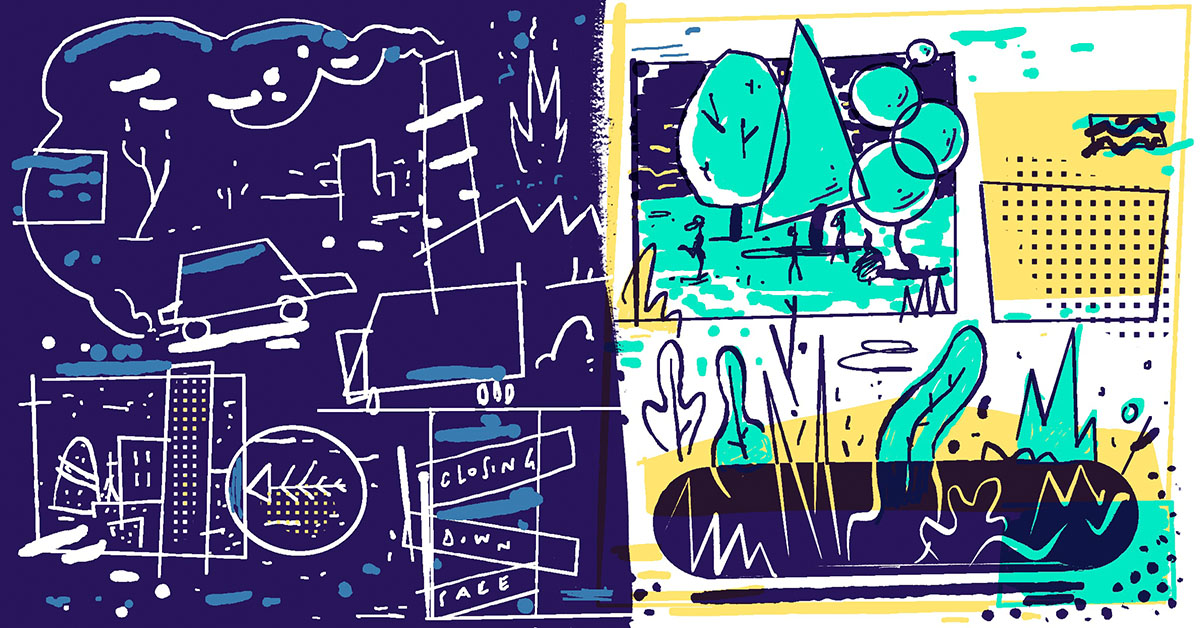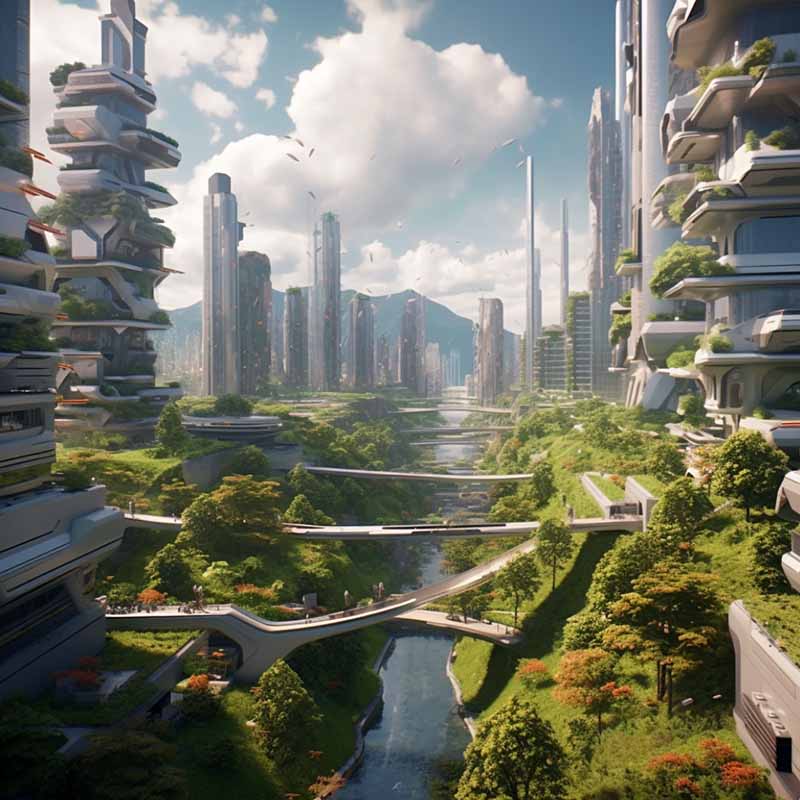Generative AI: powerful tools to imagine + explore better futures

Senior Innovation designer
Speculative Design is the discipline that imagines and explores futures that don’t yet exist. It helps us break free from the constraints of the present and allows us to envision alternative possibilities and explore these critically.
Design’s role in Futures
Its roots are in speculative and utopian literature and critical design spearheaded by pioneers like Anthony Dunne and Fiona Raby, professors at the Royal College of Art and authors of Speculative Everything. Together, with others, they have shown the value of design as a medium to question social, cultural, and ethical implications of emerging technologies and alternative futures.
Speculative Design was popularised by Designers Julian Bleeker and James Auger in early 2000s when they began using the term to describe their work, which aimed to provoke discussions about the social, cultural, and environmental consequences of emerging technologies.
Design fiction has also gained prominence during this period, with Bruce Sterling alongside other authors and designers exploring the use of storytelling and narrative techniques to envision future scenarios.
Since then these tools have been used by leading organisations from the UN, IFTF, PepsiCo and Google to explore complex issues such as climate change, biotechnology, and social inequality.
The Rise of Generative AI
We’ve seen the rise and growth of Artificial Intelligence (AI) becoming a tool that fosters innovation and breakthroughs in numerous domains. An intriguing element of AI that has recently grabbed attention is Generative AI - a type of AI systems that can generate images, text, music and other media from human prompts.
This area of AI has recently made huge advancements with the rise of ChatGPT and Claude as well as text to image generators like Midjourney and Stable Diffusion.
I’ve been experimenting with these tools for the past 4 months for various internal projects and have found these tools have huge potential for Innovation, Foresights and Systems Change.
Here’s three ways I’ve found them to be most impactful as a co-pilot:
Future narratives and storytelling
Storytelling is a powerful tool for change. These stories can play multiple different roles in Innovation. From exploring the future and critically assessing an organisation’s strengths and weaknesses, identifying new opportunities or evoking emotions about a desired future.
As part of a workstream at Torchbox we created 10 stories of the future. These were the result of us exploring various signals and drivers of change colliding (all with varying probability, but highly disruptive) across our entire ecosystem with the intent of understanding the impact of these on our organisation, and the nonprofits we work with so that we can ensure we are future ready and thrive.
GPT4 and Claude were fantastic partners to help write these scenarios, even providing us tips on storytelling structures. The outputs from these models were used as a springboard to build on further to ensure they had that human touch.
We followed a 20:60:20 or “machines in the middle” principle ensuring humans were always in the loop .
20% - Us. We crafted initial prompts with clear instructions on the context, including the desired timeframe and early iterations of our stories from the activity.
60% - GPT-4 or Claude did much of the heavy lifting with guidance from us.
20% - We refined and further crafted the outputs of the content
Below are a few examples of prompts you might use:
Hi. We have created the following scenario for the year 2030 as part of a foresight work stream. [Insert narrative here].
The audience is C suite leaders at various social non profit organisations.
Act like a world class storyteller.
Please write a short story, of no more than 300 words, and ensure it highlights the key tensions they might face.
It’s important to remember that these models are based on human language so to get the full potential out of them we need to converse with them and guide them to get the best result. There is a little back and forth needed to get to a place where you will be happy.
The stories definitely needed further refinement but not only did they unearth factors which we hadn’t yet thought of, they also saved huge amounts of time crafting these from scratch - which from experience can take far far longer than anticipated. I appreciate this is joyful to many, but without a world-class author at hand and the urgency of the work this was a huge advantage in accelerating our efforts.
A pleasant surprise was the ability to quickly and efficiently personalise these narratives by prompting GPT4 to rewrite them for the various audiences they were intended for teasing out slightly different tensions we had identified for each (shown below).
Please rewrite this narrative so that it highlights the important tensions that might exist for a nonprofit organisation who’s mission is to ensure the safe use of technology. Thank you.Tools
GPT-4 is by far the best tool for this.
Top Tip
Ensure you get your prompt just right - it needs to articulate the tension(s) in your future scenario, desired style of writing, storytelling structure, timeframe and audience to ensure they are successful. Check out our Art of the AI prompt tool which can help with some of the principles
Provocation: This experiment has also highlighted further opportunities to use GPT-4 much earlier in the process as a tool to creatively explore the impacts of multiple signals and drivers colliding.
Bring future artefacts and scenarios to life
Another invaluable skill that Designers possess is prototyping.
Bringing future products, services and stories to life both physically and visually is incredibly powerful to convey ideas, evoke emotion and bring people together around a collective vision.
Generative AI has been a fantastic co-pilot to bringing various elements of future narratives to life, visualising early ideas and our team has helped build digital tools at incredible speed.
Below are a few examples of prompts and visuals created using Midjourney to bring to life future scenarios ranging from car-less cities to healthy coral reefs in French Polynesia.
A couple of examples in mid journey using the function “/Imagine”
a future city in 2030 with no cars, thriving nature and where everything is easily walkable. Unreal engine, Ar- 16:9
This second prompt is an example of using a specific photo as a reference input:
https://media.fisheries.noaa.gov/dam-migration/3968x2976-aguijan-2017-soft-corals-evanbarba.jpg a flourishing reef with vibrant marine life in the South Pacfic Ocean French Polynesia.
Incredible organisations are already using the power of AI generated imagery to catalyse systems change through compelling visual storytelling depicting both utopian and dystopian future scenarios, the WWF’s Future of Nature Campaign is a great example of this . However, some organisations have also come [under scrutiny] (https://techhq.com/2023/05/ai-image-generation-backlash-amnesty-international/) for their use of Generative AI and there are numerous issues around potential copyright infringement so it’s vital that careful thought and consideration is given to the use case and the consequences of doing so.
Another way Generative AI can be used is as a copilot to bring digital, interactive artefacts to life. The Innovation team at Torchbox is using GPT-4 as a copilot for coding to bring multiple solutions to life quickly in order to communicate them, test desirability and validate feasibility.
My background, and much of my early career, was in the physical product space so I have seen the impact of bringing future ideas to life in physical form. These tangible objects, paired with the above are a fantastic recipe for more immersive experiences of the future. We could go even further and use AI generated voice overs, video, music and even scent for multi sensorial experiences.
Tools
Mid Journey is my favourite. Stable Diffusion or Dallee are also available. GPT-4 as a copilot for prototyping.
Top Tips
- There’s definitely a steep learning curve with image generators and it’s a little more difficult than conversing with a Tool like Claude or ChatGPT in human language. It needs very specific prompts including references, your desired outcome and any parameters. Focus on describing what you want and not what you don’t want, details matter.
- There are lots of resources available.
- Ask GPT-4 to write a prompt for you.
- Pair your visuals with physical or digital prototypes, accelerated using Generative AI as a copilot for prototyping.
Critically evaluating future solutions or scenarios
At the beginning of the article I outlined that a crucial part of Speculative Design is exploring futures critically to unpack their positive and negative impacts on the people we’re designing for, our organisations, society and our ecological systems.
During the foresights process we look for signals and drivers of change across a wide spectrum of areas, at Torchbox we use a STEEPLE framework which we analyse with figures and subsequently inform these scenarios. We need to show this same rigour and systemic approach to evaluating future scenarios and solutions.
We can use Generative AI tools to help with this.
It’s often near impossible, and very expensive, to get every voice or exert we want in a room to analyse future scenarios. It’s also challenging and time consuming to get people to break out of their natural rhythms of thinking. Although never a replacement for real people, these tools can be used to unearth problems a team may have missed or help us see solutions creatively.
Using GPT-4 we were able to ask multiple questions about scenarios and solutions from various perspectives, such as environmental experts, behavioural scientists or specific domain experts. It’s important to check these outputs but they have proved fruitful in helping unearth potential risks and opportunities (providing of course that these expert voices are in the training dataset). Here’s an example:
Hi
I’m going to share a story about the Future. [insert narrative here].
I’d like you to act as an industry leading Sociologist. We’re going to critically explore this scenario from multiple perspectives.
Let’s start with what might be positive and negative impacts on society if this was to become true?
Or an alternative example:
Hi I’m currently working on a complex problem I’d like to get your perspective on.
I’d like you to act as a leading expert in biomimicry.
Please reference Ask Nature, Biomimicry 3.8 and the biomimicry Institute.
What might be possible ways that we might be inspired by nature to create air conditioning units without the need for electricity?
I’ve also found tools like ChatGPT, GPT-4 in particular, incredibly helpful to identify problems that may have been missed during consequence scanning exercises. By conversing with GPT-4 around new solutions I’ve been able to unearth multiple unintended positive and negative impacts of solutions quickly which is incredibly valuable for both risk reduction and value identification.
Hi we're going to be discussing a brand new AI chat bot that allows people to ask questions about the SDGs. The solution is using Open AI’s GPT-4 Large Language Model. Please act like Johan Rockström. What might be the unintended consequences of this solution for the environment?
We do need to be very careful that we’re using these tools sensibly, responsibly and certainly not as a replacement for real experts or the diverse voices needed to shape solutions of tomorrow.
Tools
GPT-4 (plus Bing for browsing capabilities)
Top Tip
Ask ChatGPT or Claude to act as an industry expert or desired specific person and ensure you’re giving the right amount of context around the problem or solution. Prompts you may want include “Act as” or “You are an industry expert in the field of” to get specific perspectives.
Powerful Tools, when used responsibly
Like any technology, there are downsides to AI systems that we need to consider, mitigate and eliminate so applying responsible Innovation practices is key. You can read more about some of these in a previous article we shared. I’ll be sharing more on some of the tools in the coming weeks.
It’s also important to stress, again, that these AI tools are not a replacement for Human creativity or ingenuity. They can be, when used responsibly, fantastic enablers and incredible ways to augment a budget, time or resource restricted team.
Going beyond grammar checks or email drafters to explore generative AI creatively to help inspire the art of possibility and accelerate change will be key for us to unlock the potential in these tools for good.
 "
"
 "
"